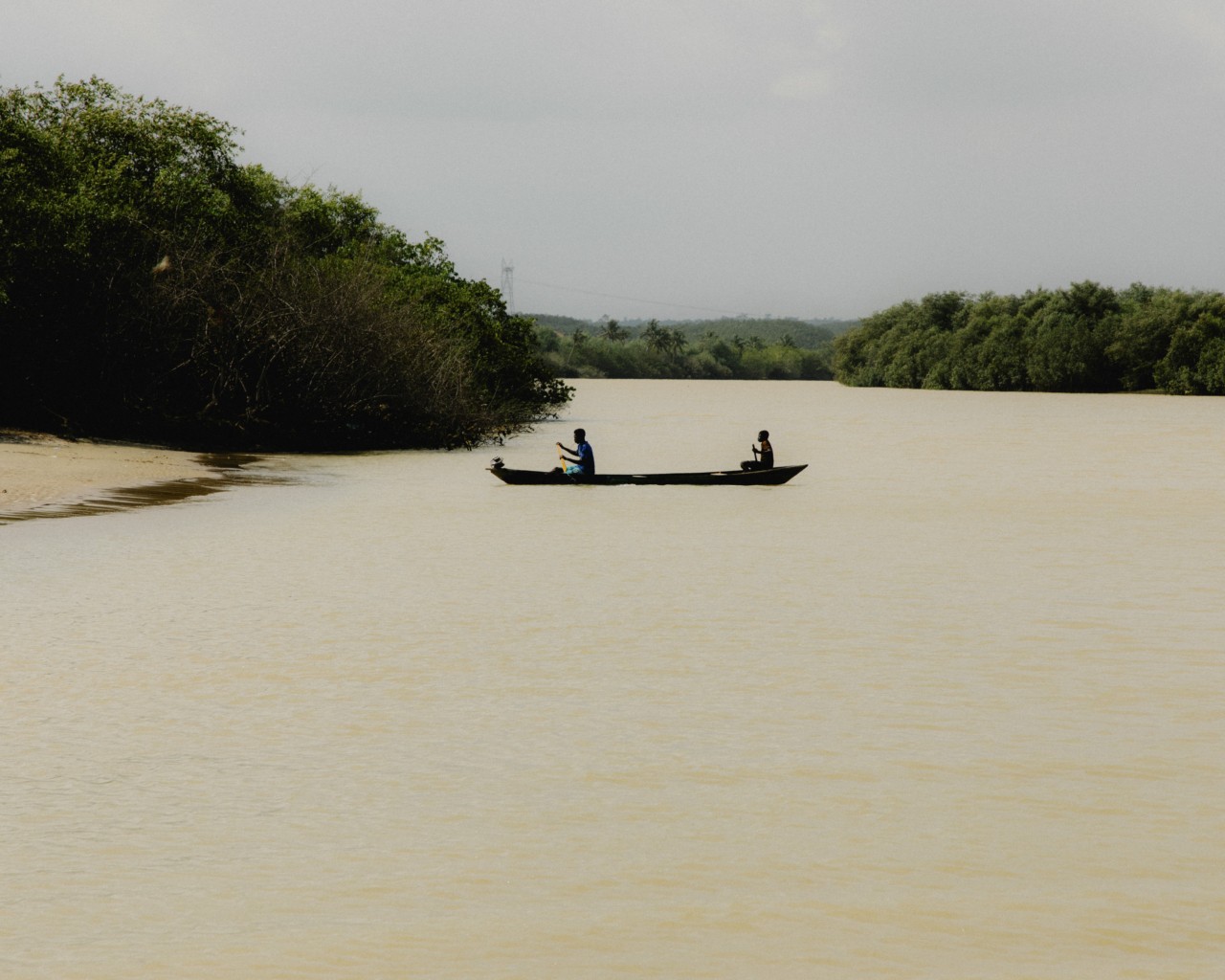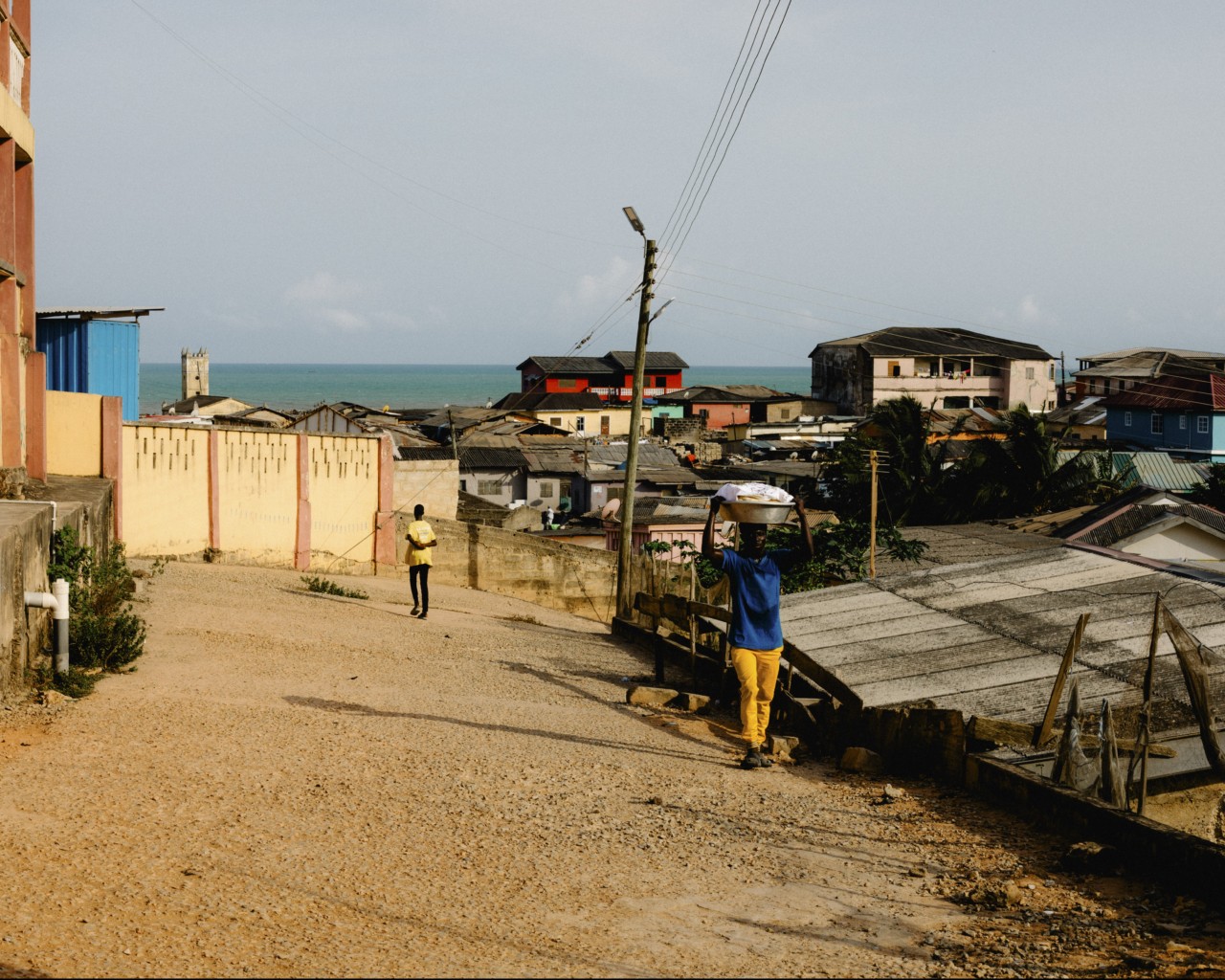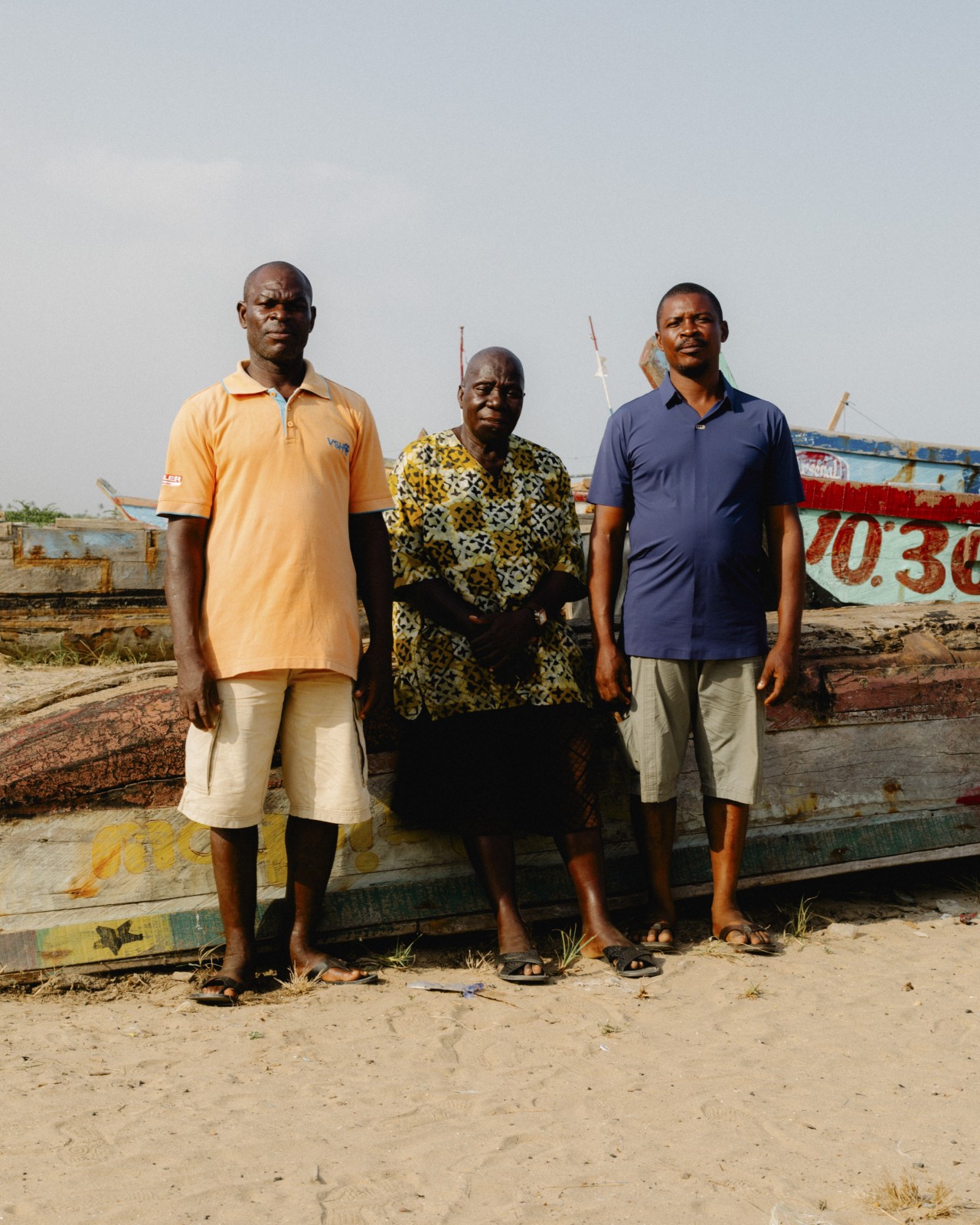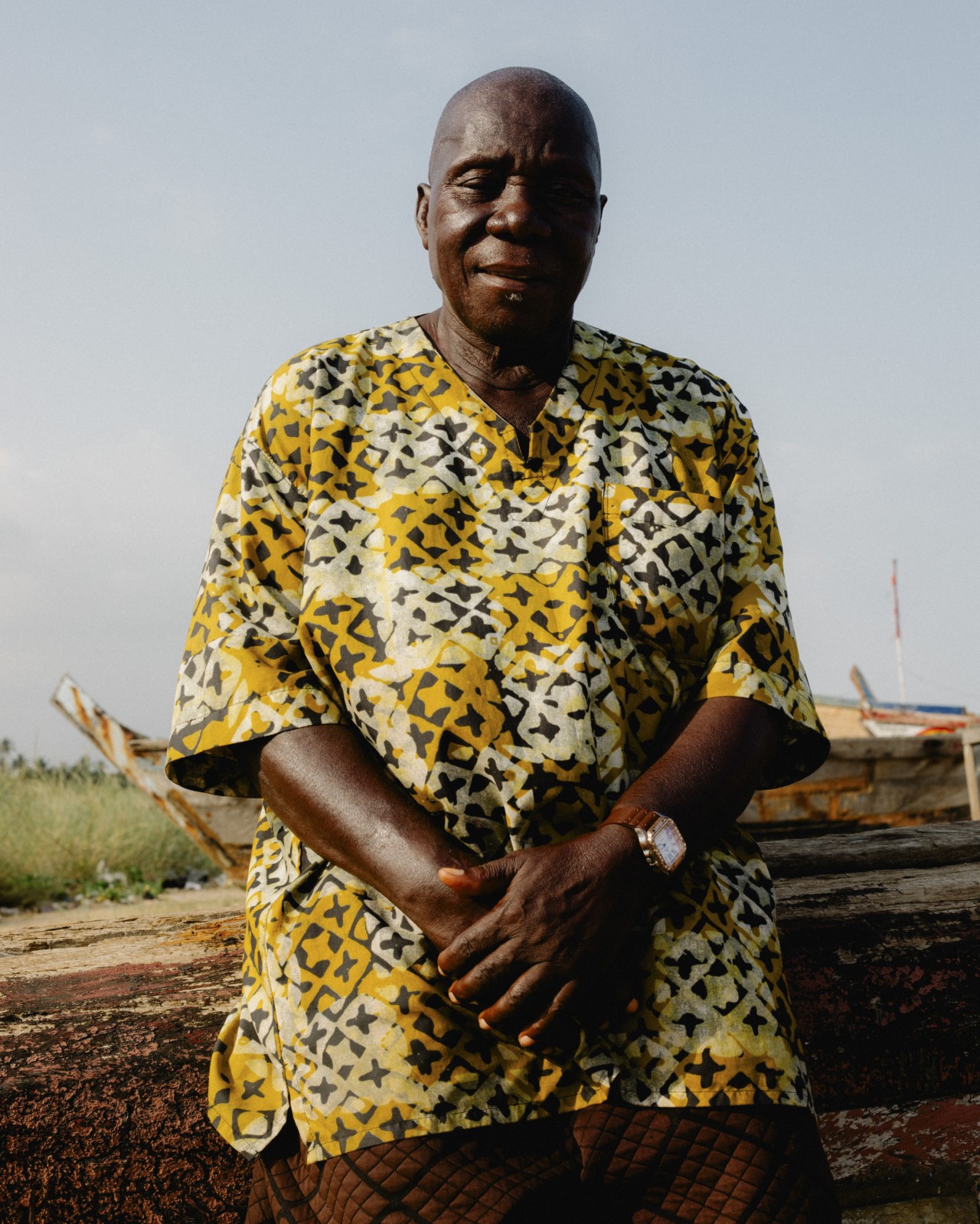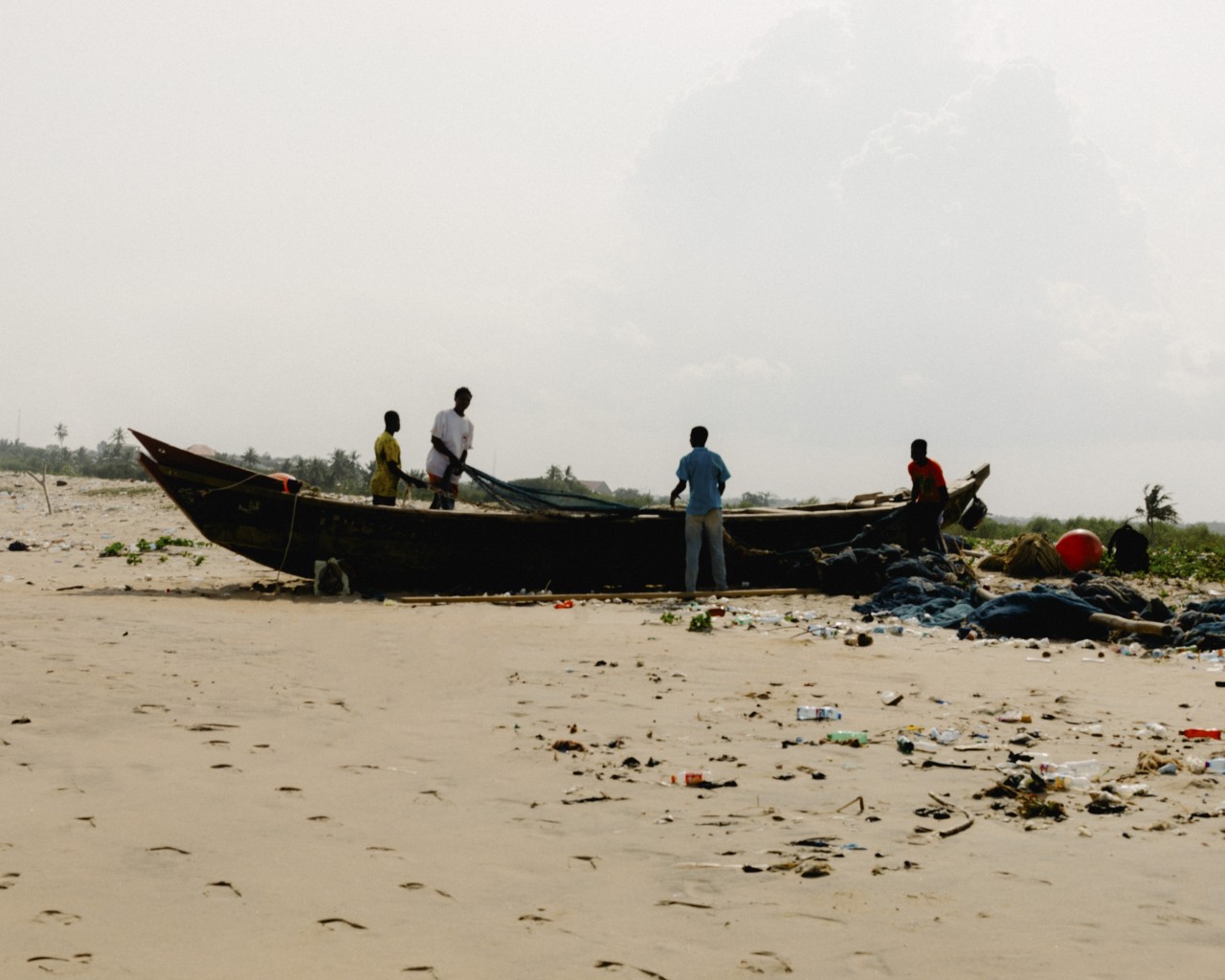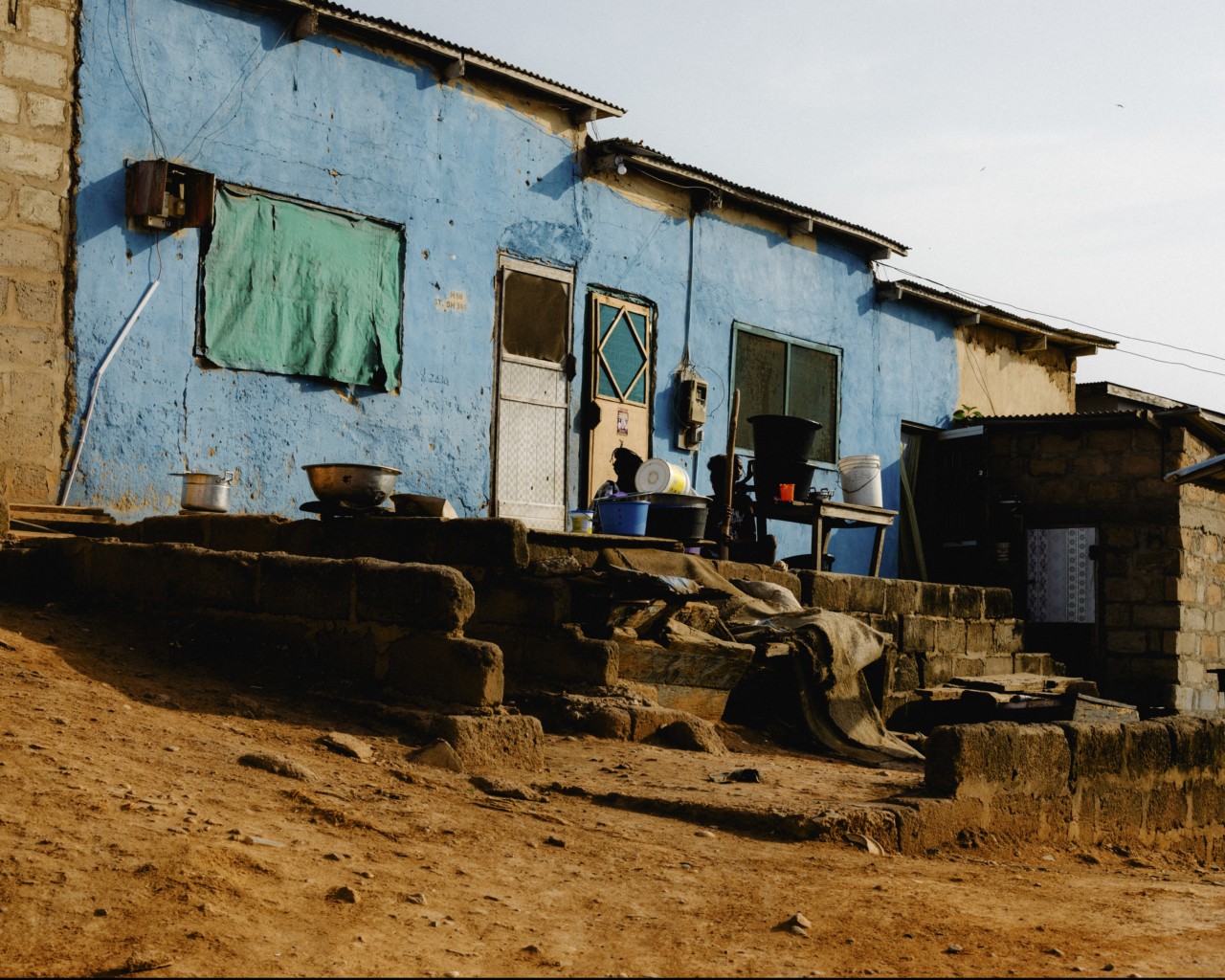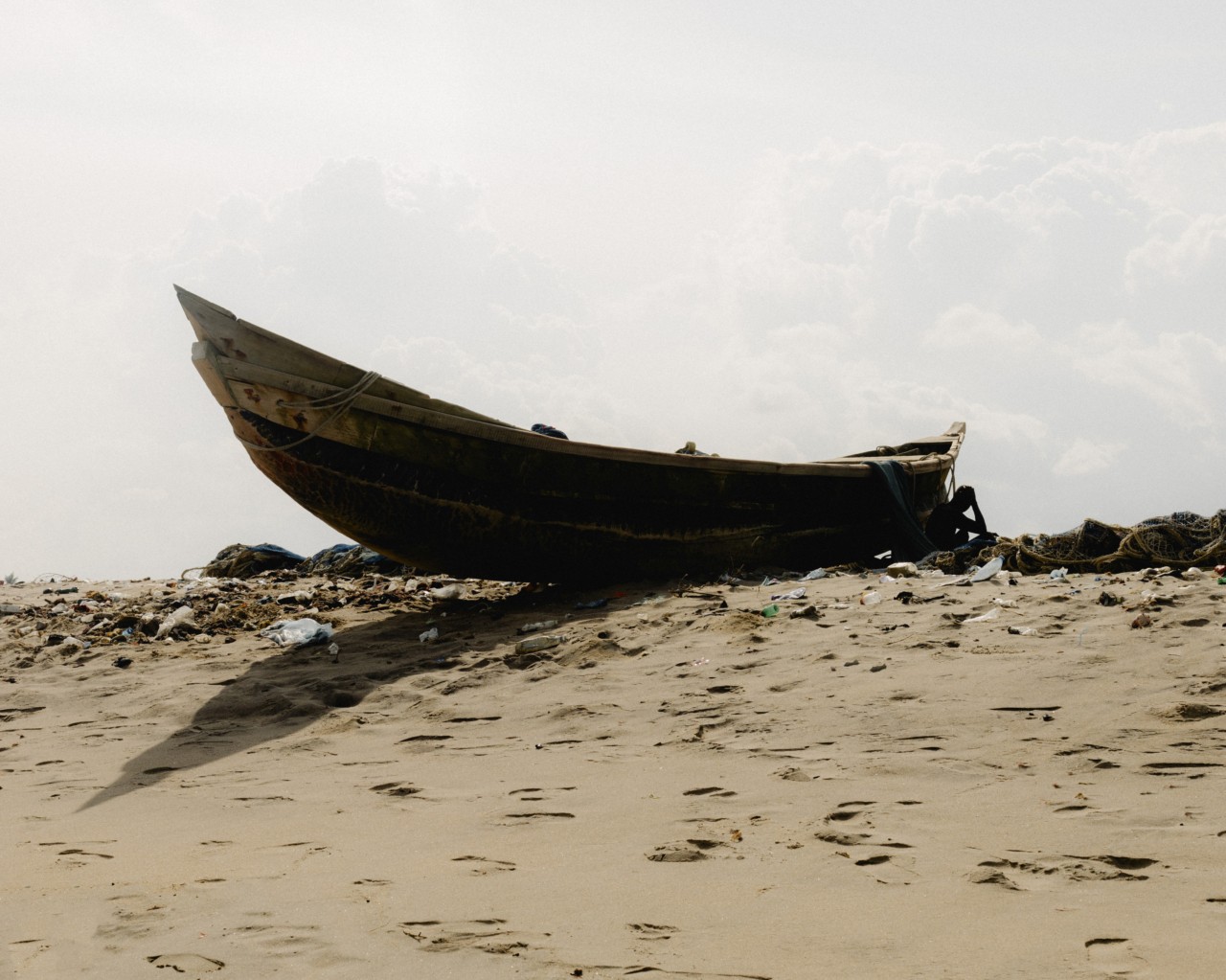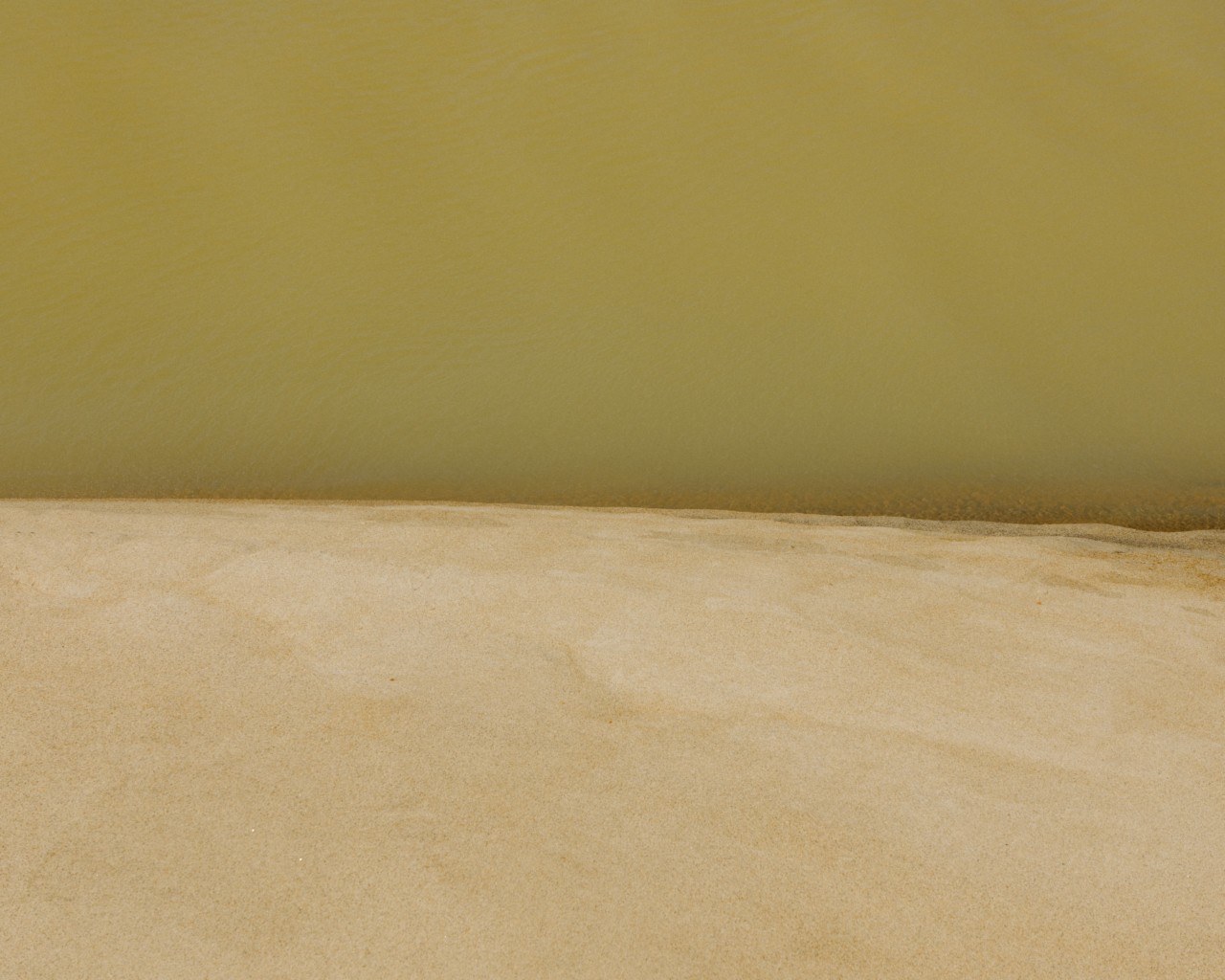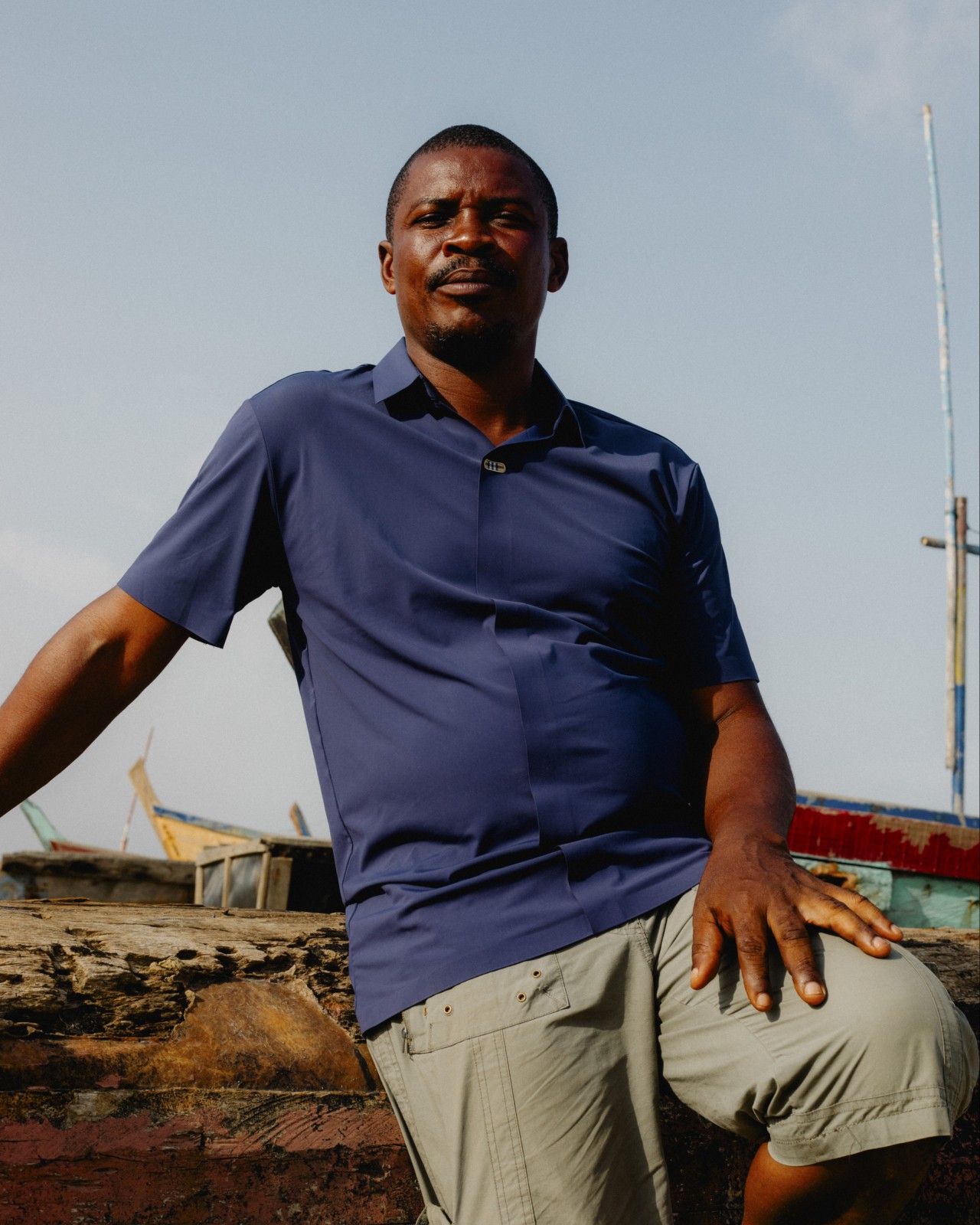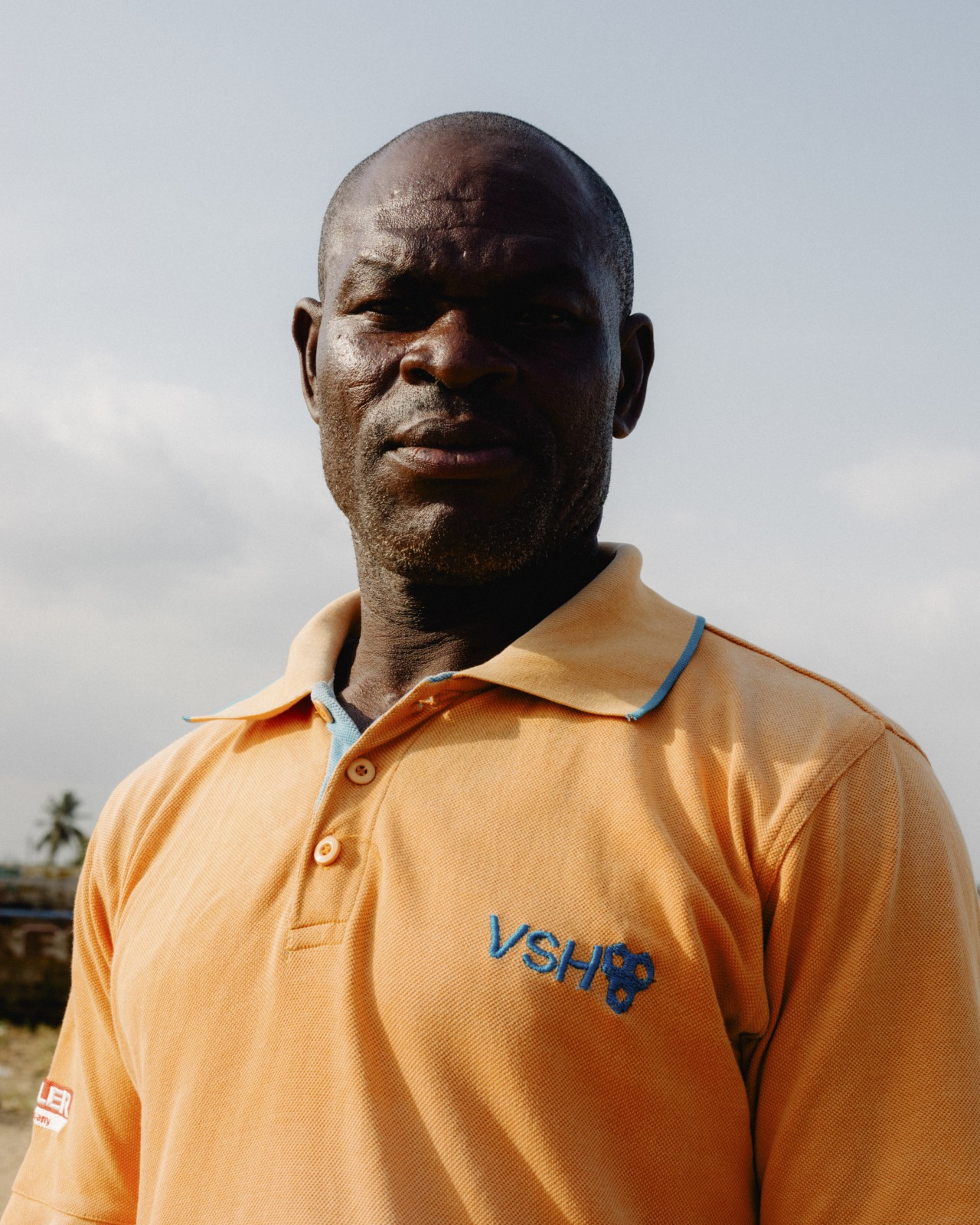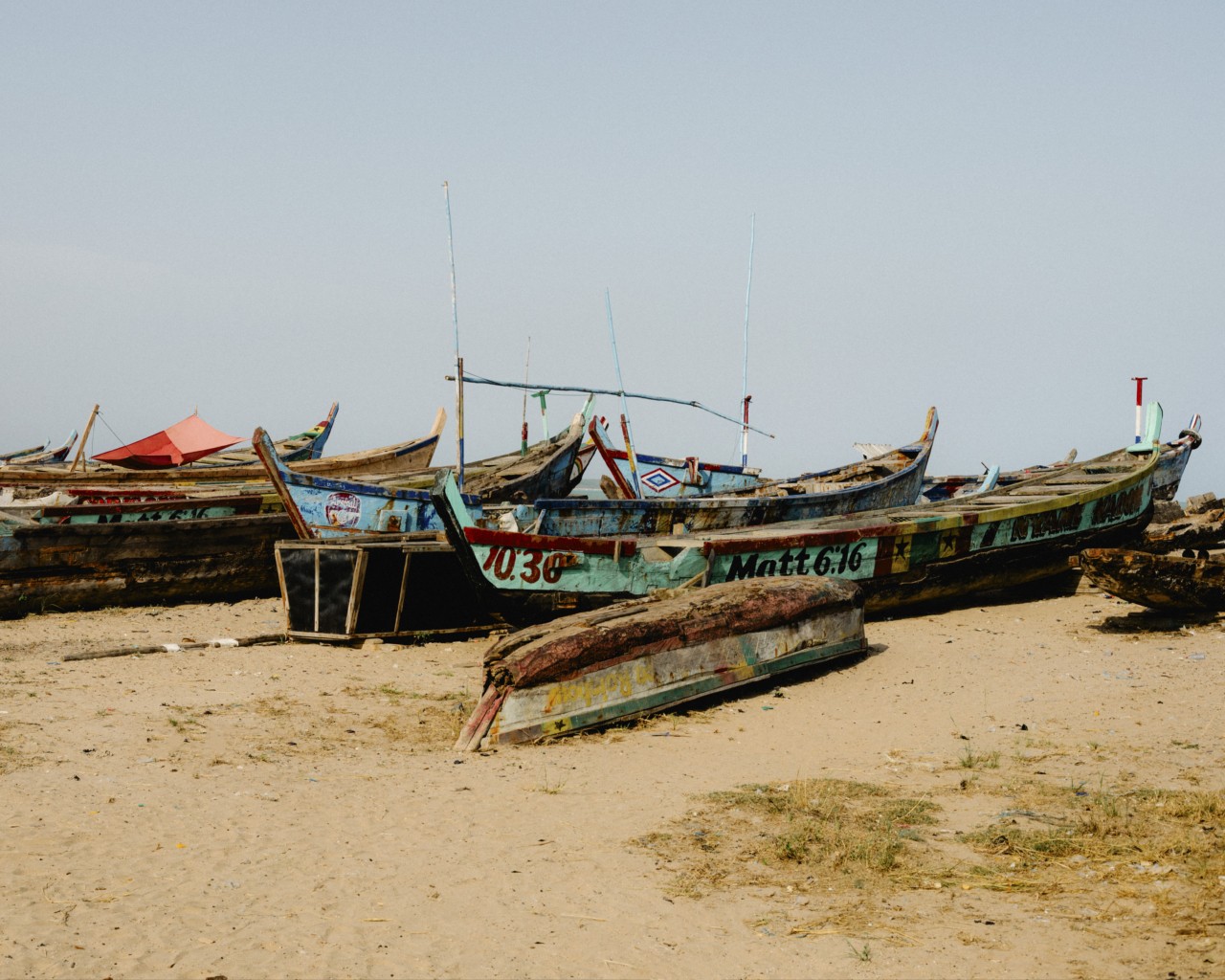
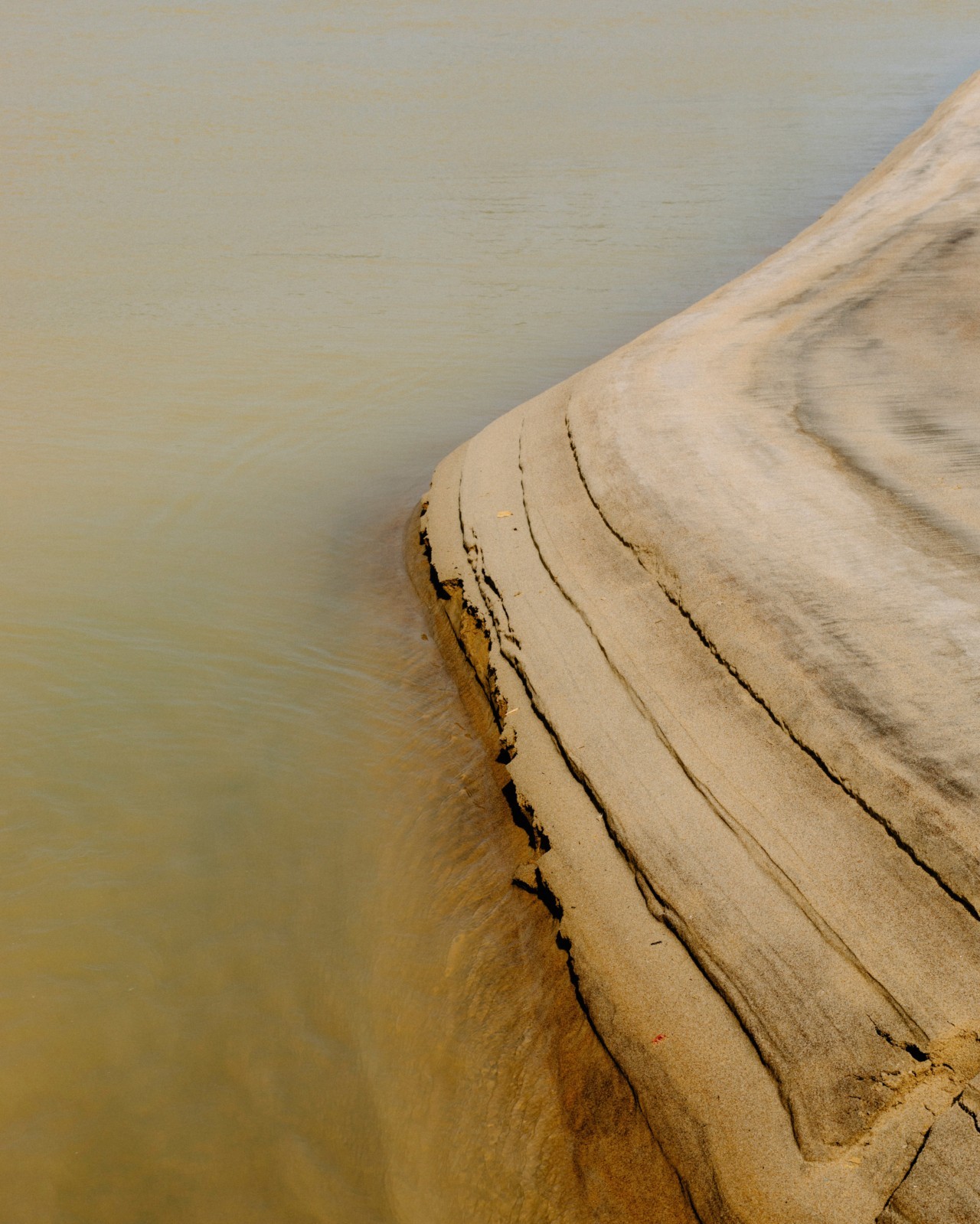
Words by Nelson C.J.
photographs by david nana opoku ansah
The sea that borders the town of Shama, a small fishing community in western Ghana, is muddy brown. From afar, the water’s surface looks coated in dust, like something a strong gust of wind can blow off. On closer inspection, however, it becomes clear this is not the case. The water is polluted—and has been for nearly four years.
Since around 2021, Shama and the surrounding sea have borne the brunt of uncurbed illegal mining activities in nearby towns known locally as galamsey—a derivative of the phrase “gather them and sell.” Shama shares a confluence with the Pra River, a major waterway that cuts across four of Ghana’s 16 regions, including towns Tarkwa Nuasem, Amenfi East, and Aboabo, where a bulk of the country’s illegal mining activities take place. It is at this junction, located just at the edge of Shama’s beach, that the Pra River began bringing pollution into the sea.
Shama isn’t a mining hub. It doesn’t remotely participate in the activity. Even so, it is one of the regions, like many places across Ghana, suffering from what scientists have described as an environmental catastrophe.
But locals say it wasn’t long since the coastline was a business hub and cultural center that buzzed all day and boasted a sea as blue as the sky. They still recall the many boats that lined the shore, and how the coastline provided a meeting point for the people of Shama. All of that is now gone. Today, the coastline has a solemn deadness to it. Fishing boats are docked, neglected and inactive, and barely anyone goes out to fish. The water is too polluted, and the fish too sick.
“We were hoping it could become a harbor,” Frank Adams Essilfie, a local of Shama, told Atmos. But in the place of that dream is now a town, grappling with the loss of its identity, robbed of the very thing that had given it life to begin with.


When Nana Ainoo Bassaw was growing up, the sea defined much of his childhood. Ainoo, now the chairman of the fishermen association in Shama, remembers walking with his mother along the coastline early in the morning. On these walks, Ainoo recalls, the water was so clean that he could see his feet from under it; it was so clean that he could drink it. And for much of life, that was the case.
Many decades later, Ainoo sits in a small shack just off the sea, looking out at the water he grew up around—unrecognizable.
On the rivers where illegal mining takes place (Pra River is one of many), miners have built large floaters that line the river banks to carry machines and help miners carry out their activities. They dig to the bottom of the river to extract gold, a process that loosens sediments and contaminating metals and leaks them into the water. The miners also use mercury, a toxic and hazardous element, to separate the soil from the gold. “And it’s not like it’s one person,” local filmmaker Kwesi “Memory” Asime said. “You [can] see hundreds of machines on similar rivers.”
Because these miners are unregulated, they aren’t required and often do not refill the pits they have dug or attempt to rehabilitate the land, leaving forests and sea areas to ruin. Locals like Frank and Ainoo say people are no longer able to swim in the sea. Worst of all, the pollution has made the coastline uninhabitable for the fish, driving them inward where it hasn’t yet reached. This doesn’t bode well for the community, which has long depended on fishing for food and income, either.


One of the major issues, according to Ainoo, is the sharp exodus of young men leaving Shama. “Fishermen now spend nearly a week at sea looking for fish when they would typically only spend a day,” Ainoo said. “Fishermen have to spend 10,000 cedis [$1,000] to fuel their boats for these long fishing trips, which dissuades young people. Now they are moving to other places or learning other skills like bus or cab driving.”
In a 2018 study about the effects of small-scale illegal mining in rural areas—also the most affected areas in Ghana—researcher Martey Laari identifies high unemployment, water pollution, and infestation from abandoned mining sites as the factors driving unregulated digging. “The major reasons that encourage galamsey were identified as higher short-term income, availability of idle lands, poor cocoa yield, and low price of cocoa,” Laari writes, adding that cocoa, alongside gold, is one of Ghana’s biggest natural resources. “Recommendations from the study include supporting farmers to maintain healthy cocoa farms, land reclamation, and public education, but also facilitating the process to ease acquisition of mining license by the galamsey operators.”
The lack of effective action on any of these recommendations enables a culture of infrastructural negligence, and an administration whose response to Ghana’s environmental problems have been largely insufficient.

The Ghana Water Company Limited released a statement last August warning of a possible water shortage due to the pollution of the Pra River by illegal mining. In the statement, the central regional office shared that the problem was so dire it also affected the water treatment plant, which was unable to adequately clean contaminated water due to high toxicity levels and insufficient raw water sources.
“About 60% of the catchment capacity is silted due to illegal mining, compromising water quality,” read the statement, which has circulated widely online. “We are currently recording an average turbidity of 14,000 NTU, far exceeding the designed level of 2000 NTU for adequate treatment.” The plant continues to only produce about one-quarter of its installed capacity.
“We don’t know how things will return to normal or how soon it will happen. We are just hoping that the galamsey will be stopped, especially in the rivers. And that, maybe with time, the sediments will settle and the coast will be clean again.”
The news spurred a wave of demonstrations from young Ghanaians. In October, protesters took to the city center calling for accessible clean water for all, but were met with police resistance and arrests.
Although the protests made headlines, and locals in affected areas like Shama have repeatedly raised the alarm, little has been done by the government to decisively tackle the issue. Former President Nana Addo set up a committee to address the problem, but many locals say the culprits receive protections from within the committee itself, which includes other locals who cite high poverty rates as their motivation for facilitating and participating in illegal mining. Then, there are the political office holders and people of influence who are actively financing the machinery used to carry out these activities—and profiting from it, too. Locals say there’s a clear conflict of interest: Those expected to regulate illegal mining activities have hindered progress to line their own pockets, putting the health and well-being of frontline communities most affected by contaminated water in danger.


There’s an economic argument for greater regulation, too. Enoch Aikins, a writer and researcher at the Institute for Security Studies who has published work examining the socio-economic impact of galamsey, said the economic impact of galamsey cannot be underestimated. As an informal sector, Ghana currently loses $2 billion in taxes annually to illegal gold mining. In 2022, 60 tons of gold were smuggled out of the country; most ended up in the United Arab Emirates.
If mining was properly regulated, however, employment opportunities for Ghanaians would grow, while local communities would be saved from environmental damage and dwindling economic opportunities. Simply put: If mining was regulated, Ghana would not be at risk of possibly having to import clean water by 2040—a worrying development shared by researchers from the University of Cape Coast, Ghana.
Aikins attributes the continued practice of illegal mining to a conscious act of self-destruction. “Galamsey gives you quick returns and most young people are looking for quick ways to make money and to survive,” he said. With the contamination of public and planetary health, however, these financial benefits are sure to be short-lived.

Despite the overwhelming campaigns and infomercials aimed at raising awareness of the issue, Aikins stresses that the perpetrators of illegal mining remain unwilling to stop—even as their waters turn brown and cause medical complications that have been linked to birth defects.
“It’s not that people are not aware of the impact of galamsey,” the researcher told Atmos, “but that we don’t have an alternative. In the long run, we will die anyway. So, why should we wait for some people who are politically connected to benefit from it and still pollute our water? Especially when we can benefit from it, too? Either way, we still end up drinking the polluted water.”
The way forward, as Aikins sees it, is to establish safe mining practices to incentivize galamsey participants. He also stresses that the president must revoke licenses that permit miners to conduct mining activities in forest reserves and river bodies. “You cannot tackle galamsey without tackling alternative livelihoods and responsible community mining,” he said. Alongside that, a stricter policy concerning those entrusted with curbing galamsey activities is a necessary and urgent step in the right direction.
Shama Sea is not small, so nobody could have anticipated that the pollution from Pra River would be as consequential as it is today. “There were talks in town of rivers getting dirty and there was evidence of it,” Kwesi “Memory” Asime said, “but those water bodies were close to where the mining was happening.”


Asime, who grew up between Shama and Ghana’s capital city Accra, remembers when he first noticed the pollution of the Shama Sea during a trip home a few years back. At the time, he was working on a documentary about an NGO aimed at stopping child labor in the fishing, mining, and cocoa sectors. “I was in town to see family,” he said, “and as we often did, my cousin and I went to the beach—but it was different.” The Shama Sea wasn’t as brown as it is now, but even then its discoloration came as a huge shock to someone who grew up seeing “people from neighboring communities come to the coast to fish.”
The effect of galamsey, and the stories of the people perpetuating it, are the focus of Asime’s new documentary. As someone so tied to the land, his film is creating an artistic outlet that helps him process the loss of a place that no longer looks the same; a place that, in the absence of any immediate regulatory efforts, can only dream of a brighter, cleaner, and safer future. “We don’t know how things will return to normal or how soon it will happen,” Asime told Atmos. “We are just hoping that the galamsey will be stopped, especially in the rivers. And that, maybe with time, the sediments will settle and the coast will be clean again.”
In Shama, there is today only one indication of how clear the sea used to be. That’s a lake, not far from the beach, but cut off from the sea itself. Surrounded by grass and navigable only by boat, the lake, even on a glum day, is crystal clear. It is, in many ways, a reminder of what used to be: an identity lost and the fear of a future that remains as unclear as the waters the community is so desperately trying to salvage.

A New Gold Rush Is Turning Ghana’s Water Into Poison
